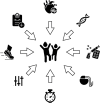A narrative review of inherited arrhythmogenic syndromes in young population: role of genetic diagnosis in exercise recommendations
- PMID: 38975025
- PMCID: PMC11227825
- DOI: 10.1136/bmjsem-2023-001852
A narrative review of inherited arrhythmogenic syndromes in young population: role of genetic diagnosis in exercise recommendations
Abstract
Sudden cardiac death is a rare but socially devastating event, especially if occurs in young people. Usually, this unexpected lethal event occurs during or just after exercise. One of the leading causes of sudden cardiac death is inherited arrhythmogenic syndromes, a group of genetic entities characterised by incomplete penetrance and variable expressivity. Exercise can be the trigger for malignant arrhythmias and even syncope in population with a genetic predisposition, being sudden cardiac death as the first symptom. Due to genetic origin, family members must be clinically assessed and genetically analysed after diagnosis or suspected diagnosis of a cardiac channelopathy. Early identification and adoption of personalised preventive measures is crucial to reduce risk of arrhythmias and avoid new lethal episodes. Despite exercise being recommended by the global population due to its beneficial effects on health, particular recommendations for these patients should be adopted considering the sport practised, level of demand, age, gender, arrhythmogenic syndrome diagnosed but also genetic diagnosis. Our review focuses on the role of genetic background in sudden cardiac death during exercise in child and young population.
Keywords: Child; Exercise; Genetics; Review; Young.
© Author(s) (or their employer(s)) 2024. Re-use permitted under CC BY-NC. No commercial re-use. See rights and permissions. Published by BMJ.
Conflict of interest statement
Competing interests: None declared.
Figures


Similar articles
-
Cardiac channelopathies in pediatrics: a genetic update.Eur J Pediatr. 2024 Nov;183(11):4635-4640. doi: 10.1007/s00431-024-05757-3. Epub 2024 Sep 23. Eur J Pediatr. 2024. PMID: 39307882 Review.
-
Incomplete Penetrance and Variable Expressivity: Hallmarks in Channelopathies Associated with Sudden Cardiac Death.Biology (Basel). 2017 Dec 26;7(1):3. doi: 10.3390/biology7010003. Biology (Basel). 2017. PMID: 29278359 Free PMC article. Review.
-
Genetic Variants as Sudden-Death Risk Markers in Inherited Arrhythmogenic Syndromes: Personalized Genetic Interpretation.J Clin Med. 2020 Jun 15;9(6):1866. doi: 10.3390/jcm9061866. J Clin Med. 2020. PMID: 32549272 Free PMC article. Review.
-
Role of microRNAs in arrhythmogenic cardiomyopathy: translation as biomarkers into clinical practice.Transl Res. 2023 Sep;259:72-82. doi: 10.1016/j.trsl.2023.04.003. Epub 2023 Apr 25. Transl Res. 2023. PMID: 37105319 Review.
-
Genetics of inherited arrhythmias in pediatrics.Curr Opin Pediatr. 2015 Dec;27(6):665-74. doi: 10.1097/MOP.0000000000000272. Curr Opin Pediatr. 2015. PMID: 26371946 Review.
